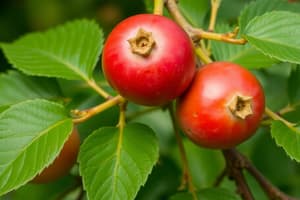Podcast
Questions and Answers
What does olericulture focus on?
What does olericulture focus on?
- Turfgrass management
- Fruit cultivation
- Ornamental crops
- Vegetable cultivation (correct)
Which branch of horticulture is concerned with grapevines?
Which branch of horticulture is concerned with grapevines?
- Floriculture
- Landscape Horticulture
- Pomology
- Viticulture (correct)
What is a primary benefit of horticulture in terms of environmental impact?
What is a primary benefit of horticulture in terms of environmental impact?
- Decreased soil health
- Monoculture farming
- Enhanced biodiversity (correct)
- Increased pollution
Which technique helps shape plants to improve their yield?
Which technique helps shape plants to improve their yield?
What issue is a significant challenge for horticulture due to climate change?
What issue is a significant challenge for horticulture due to climate change?
What role does turf management serve in horticulture?
What role does turf management serve in horticulture?
Which trend focuses on growing food in urban environments?
Which trend focuses on growing food in urban environments?
What tools are essential for efficient irrigation in horticulture?
What tools are essential for efficient irrigation in horticulture?
Flashcards are hidden until you start studying
Study Notes
Definition
- Horticulture is the science and art of growing fruits, vegetables, nuts, seeds, herbs, mushrooms, algae, flowers, seaweeds, and non-food crops.
Branches of Horticulture
- Pomology: Study of fruit cultivation.
- Olericulture: Study of vegetable cultivation.
- Floriculture: Cultivation of flowering plants and ornamental crops.
- Landscape Horticulture: Design and maintenance of landscapes.
- Viticulture: Cultivation of grapevines for winemaking.
- Turf Management: Management of turfgrass for sports and recreational purposes.
Importance of Horticulture
- Food Production: Essential for providing nutritious food.
- Economic Contribution: Significant sector in agriculture, providing jobs and income.
- Environmental Benefits: Enhances biodiversity, improves air quality, and supports ecosystems.
- Aesthetic Value: Contributes to beauty and recreational spaces in urban and rural areas.
Techniques in Horticulture
- Propagation: Methods of plant reproduction (seeds, cuttings, grafting).
- Soil Management: Ensuring soil health through amendments and practices.
- Irrigation: Efficient water management systems (drip, sprinkler).
- Pest Management: Integrated pest management (IPM) strategies to control pests sustainably.
- Pruning and Training: Techniques to shape plants and improve yield.
Tools and Equipment
- Hand tools: Pruners, hoes, and trowels.
- Power tools: Tractors, tillers, and mowers.
- Irrigation systems: Hoses, drip lines, and sprinkler systems.
- Greenhouses: Controlled environments for plant growth.
Trends in Horticulture
- Sustainable Practices: Organic farming and permaculture.
- Urban Horticulture: Growing food in urban spaces (rooftop gardens, community gardens).
- Technological Advancements: Use of precision agriculture and smart technology in monitoring crops.
- Vertical Farming: Growing crops in stacked layers to save space and resources.
Challenges in Horticulture
- Climate Change: Impact on crop yields and growing seasons.
- Pests and Diseases: Resistance development and management issues.
- Water Scarcity: Need for efficient water usage and conservation.
- Market Access: Challenges for small-scale farmers to reach consumers.
Educational Pathways
- Degrees in horticulture, plant science, or agricultural science.
- Specialized courses in specific branches like floriculture or landscape design.
- Hands-on experience through internships and apprenticeships in nurseries and farms.
Definition
- Horticulture integrates science and art to cultivate various plant types, including fruits, vegetables, flowers, and non-food crops.
Branches of Horticulture
- Pomology focuses on fruit cultivation techniques and varieties.
- Olericulture covers the cultivation of vegetables, emphasizing crop management.
- Floriculture is dedicated to the production of flowering plants and ornamental horticulture.
- Landscape Horticulture involves the design, installation, and maintenance of aesthetic landscapes.
- Viticulture specializes in grapevine cultivation, primarily for wine production.
- Turf Management centers on the care and maintenance of turfgrass used in sports and recreational areas.
Importance of Horticulture
- Horticulture plays a crucial role in food production, providing essential nutrients and variety in diets.
- It is a significant contributor to the economy, creating jobs and generating income within the agricultural sector.
- Benefits the environment by enhancing biodiversity, purifying air, and supporting various ecosystems.
- Adds aesthetic value by creating beautiful, functional green spaces in both urban and rural settings.
Techniques in Horticulture
- Propagation techniques include seed germination, cuttings, and grafting for plant reproduction.
- Soil Management ensures soil health through the use of organic amendments and cultivation practices.
- Irrigation systems such as drip and sprinkler offer efficient water distribution for plant health.
- Pest Management uses integrated pest management (IPM) for sustainable pest control methods.
- Pruning and Training methods shape plant growth and enhance yield quality.
Tools and Equipment
- Hand tools include pruners, hoes, and trowels for basic gardening tasks.
- Power tools such as tractors, tillers, and mowers aid in larger-scale operations.
- Various Irrigation Systems like hoses, drip lines, and sprinklers optimize water usage.
- Greenhouses provide controlled environments conducive to plant growth.
Trends in Horticulture
- Sustainable Practices emphasize organic farming and permaculture to enhance environmental health.
- Urban Horticulture promotes the cultivation of food in city settings through initiatives like rooftop and community gardens.
- Technological Advancements in agriculture include precision farming and smart tech for crop monitoring.
- Vertical Farming utilizes stacked layers for growing crops, conserving space and resources efficiently.
Challenges in Horticulture
- Climate Change poses risks to crop yields and alters growing conditions, requiring adaptive strategies.
- Pests and Diseases present management challenges due to developing resistance in pest populations.
- Water Scarcity demands improved water efficiency and conservation practices in horticulture.
- Market Access creates hurdles for small-scale farmers, limiting their ability to reach consumers effectively.
Educational Pathways
- Pursue degrees in horticulture, plant science, or agricultural science to enter the field.
- Specialized courses enhance knowledge in areas such as floriculture and landscape design.
- Gain hands-on experience through internships or apprenticeships in nurseries and farms to apply theoretical knowledge.
Studying That Suits You
Use AI to generate personalized quizzes and flashcards to suit your learning preferences.




